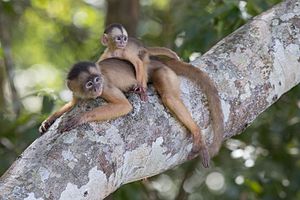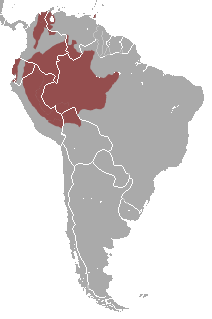White-browed capuchin monkey
| White-browed capuchin monkey | ||||||||||||
|---|---|---|---|---|---|---|---|---|---|---|---|---|

White-fronted capuchin monkey ( Cebus albifrons ) |
||||||||||||
| Systematics | ||||||||||||
|
||||||||||||
| Scientific name | ||||||||||||
| Cebus albifrons | ||||||||||||
| ( Humboldt , 1812) |
The white-fronted capuchin monkey ( Cebus albifrons ) is a primate species from the genus of the capuchin monkey . It is similar to the closely related white-shouldered capuchin , but remains a little smaller.
features
White-fronted capuchin monkeys reach a head-trunk length of about 34 to 37.5 centimeters, the tail reaches a length of 41 to 46 centimeters. The weight varies between 2.1 and 2.6 kilograms, with the males becoming significantly heavier. The physique of these primates is slender, the limbs are long and thin. Their fur is light gray-brown on the back, the belly is lighter, the limbs are darker, and the hands and feet are yellow-brown. The flesh-colored face is surrounded by a wreath of cream-colored hair, and there is a black cap on the top of the head. The top of the tail is ash gray, the underside whitish, towards the tip it becomes brown-black.
distribution and habitat
White-browed capuchin monkeys are native to northwestern South America. Its range begins in the north in the southern Venezuelan region of the Amazon and is bordered in the south by the Río Putumayo and the Amazon . In the east they occur to the mouth of the Río Putumayo in the Amazon, in the west to the headwaters of Río Cauca and Río Putumayo in southwestern Colombia. Their habitat are different forest forms, primary and secondary rainforests, gallery forests , Várzea forests and hardwood forests with small-leaved trees. In the northern Andes they occur up to 2000 meters above sea level.
Way of life
White-fronted capuchin monkeys are diurnal and mostly stay in the trees, but they also come to the ground to forage. You move on all fours. They live in groups of 15 to 35 animals, which consist of several males, females and the common young animals. Both sexes develop a hierarchy that is used, among other things, in mutual grooming and reproduction. Popular sleeping trees are the Attalea maripa palm trees, whose crowns protrude 25 to 30 meters above the ground.
White-browed capuchin monkeys have a polygamous reproductive behavior, the dominant male fathered most of the young. After a gestation period of 162 to 180 days, the female usually gives birth to a single young. The males take part in the care of the young and often carry young animals that are not yet able to climb. White-fronted capuchin monkeys can live up to 44 years. Among the predators of the White-fronted Capuchin monkeys include the harpy eagle , the splendor Hawk-Eagle ( Spizaetus ornatus ), the Elster Adler ( Spizastur melanoleucus ) and the Tayra .
nutrition
In the Colombian nature park El Tuparro , the diet of the white-fronted capuchin monkey was examined more closely. About 80% of the time spent foraging for food, the monkeys are in search of and eating fruits, nuts, seeds, leaves, flowers and sprouts, the remaining 20% of the time are animal food (insects, spiders and other invertebrates , Tree frogs and small lizards) and the honey eaten by stingless bees . The fruits of the Buriti palm , of palms of the genus Bactris and of Attalea maripa , Oenocarpus bataua and Syagrus orinocensis , as well as figs and the fruits of passion flowers , Oxandra glabra ( annone family ), Goupia glabra , Dipteryx and Inga ( legumes ) are important.
White-browed capuchin monkeys often come to the ground to eat fallen fruit or those of the non- epiphytic bromeliads pineapple and bromelia , or to look for insects in the fallen leaves. Over time, paths emerge that you use again and again. They quench their thirst with water from tree holes, from the leaves of Strelitzia and from the puddles on the ground.
Systematics
The white-fronted capuchin monkey was first described as Simia albifrons by the German naturalist Alexander von Humboldt in 1812 . The type specimens come from the rapids of the Orinoco . Today he is placed within the capuchin monkey in the genus of the unhulled capuchin ( Cebus ). A number of subspecies have been described and given the status of distinct species in the Handbook of the Mammals of the World .
See: Ecuador capuchin monkey ( Cebus aequatorialis ), Peru capuchin monkey ( Cebus cuscinus ), Spix's capuchin monkey ( Cebus unicolor ), and Colombia capuchin monkey ( Cebus versicolor ).
The monkeys on the island of Trinidad , originally assigned to the white- fronted capuchin as subspecies Cebus albifrons trinitatis , are a population of the Venezuela capuchin monkey ( Cebus brunneus ) that may have been introduced by humans. In the headwaters of the Río Cauca in southern Colombia, the white-fronted capuchin monkey hybridizes with the white-shouldered capuchin ( Cebus capucinus ).
Danger
Hunting for their meat and the destruction of their habitat are the main threats to the white-browed capuchin monkeys. Although these factors are decimating the overall population, they are not yet to a worrying extent. The IUCN lists the species as "not endangered" ( least concern ).
literature
- Thomas Geissmann : Comparative Primatology. Springer-Verlag, Berlin a. a. 2003, ISBN 3-540-43645-6 .
- Don E. Wilson, DeeAnn M. Reeder (Eds.): Mammal Species of the World. A taxonomic and geographic Reference. Johns Hopkins University Press, Baltimore MD 2005, ISBN 0-8018-8221-4 .
- Anthony B. Rylands, Russell A. Mittermeier, Bruna M. Bezerra, Fernanda P. Paim & Helder L. Queiroz: Family Cebidae (Squirrel Monkeys and Capuchins). Pages 408 to 409 in Russell A. Mittermeier , Anthony B. Rylands & Don E. Wilson : Handbook of the Mammals of the World: - Volume 3. Primates. Lynx Editions, 2013 ISBN 978-84-96553-89-7
Individual evidence
- ↑ a b c d Rylands, Mittermeier, Bezerra, Paim & Queiroz (2013), page 408.
- ↑ a b Rylands, Mittermeier, Bezerra, Paim & Queiroz (2013), page 409.
- ↑ Rylands, Mittermeier, Bezerra, Paim & Queiroz (2013), pages 408 to 409.
- ↑ Rylands, Mittermeier, Bezerra, Paim & Queiroz (2013), pages 407 to 412.
- ↑ Rylands, Mittermeier, Bezerra, Paim & Queiroz (2013), p. 410.
- ^ IUCN entry

